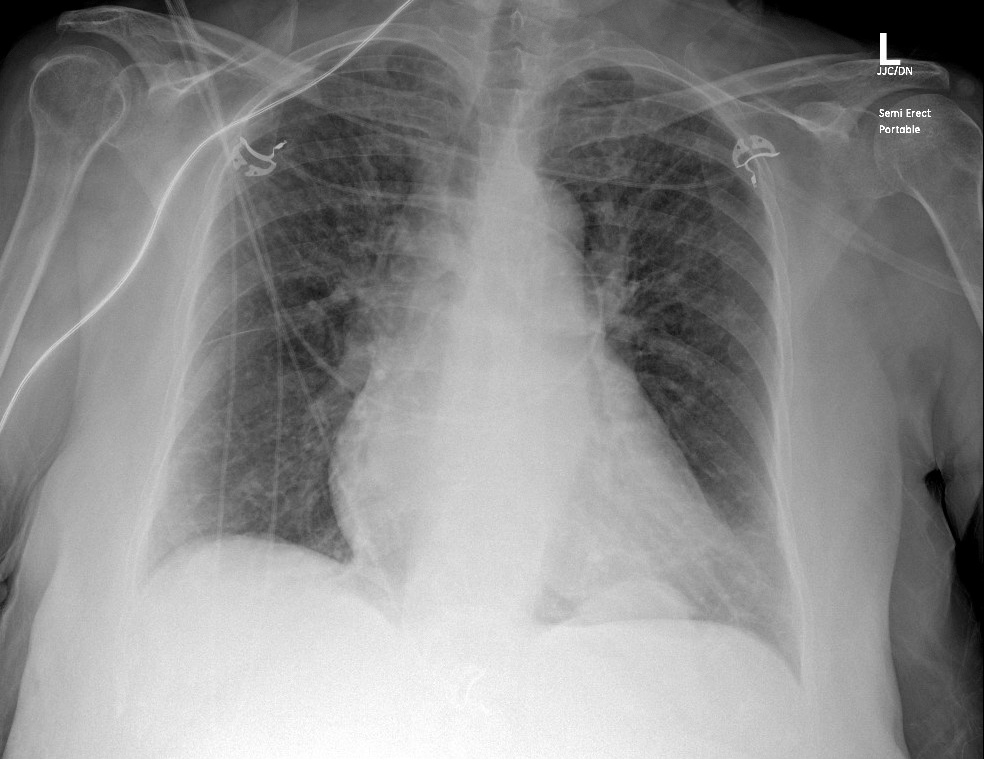Sunday Poster Session
Category: Esophagus
P0743 - Adult Bochdalek Hernia Mimicking Cardiopulmonary Exacerbation: A Diagnostic Challenge
Sunday, October 26, 2025
3:30 PM - 7:00 PM PDT
Location: Exhibit Hall

Abdul Muqtadir, MD
West Anaheim Medical Center
Anaheim, CA
Presenting Author(s)
Abdul Muqtadir, MD, Hassan Buhulaigah, MD, Hossein Rajali, MD, Sadaf Hassanzada, MD, Javed Sadiq, MD, Essam Quraishi, MD, Joshua Peloquin, DO
West Anaheim Medical Center, Anaheim, CA
Introduction: Bochdalek hernia is a congenital posterolateral diaphragmatic defect typically diagnosed in neonates. Adult presentations are rare and often present with nonspecific respiratory or gastrointestinal symptoms. We present a case of an adult Bochdalek hernia in a patient with overlapping cardiopulmonary comorbidities, highlighting the importance of imaging in establishing an accurate diagnosis in resistant cases.
Case Description/
Methods: A 63-year-old woman with a medical history of COPD, congestive heart failure, cervical radiculopathy, and obesity presented to the emergency department with progressive shortness of breath, chest pressure, upper abdominal discomfort, and persistent burping. She also reported worsening lower extremity edema and had not had a bowel movement in three days. On examination, she appeared uncomfortable, preferred to sit upright, and had reduced breath sounds in the lower lung fields. Vitals were notable for hypertension (BP 170/116 mmHg), tachycardia (HR 139 bpm), and tachypnea (RR 28/min). Initial laboratory workup revealed elevated BNP and mild leukocytosis. Chest radiograph showed a large radiolucent area beneath the left hemidiaphragm, interpreted as a gastric bubble. The patient was treated for COPD exacerbation with concomitant CHF exacerbation with bronchodilators, steroids, diuretics, and antibiotics without full clinical improvement and persistent symptoms.
Given persistent symptoms and diagnostic uncertainty, CT of the chest and abdomen was obtained, revealing a large left-sided Bochdalek hernia with herniation of the stomach and bowel loops into the thoracic cavity, causing mediastinal shift and lung compression. She was discharged with outpatient surgical and gastrointestinal follow-up for elective hernia repair.
Discussion: Bochdalek hernias are rare congenital diaphragmatic defects typically diagnosed in neonates but can present in adults with nonspecific respiratory or gastrointestinal symptoms. Incidence in adults is estimated at 0.17–0.76% on CT imaging. Left-sided hernias are more common and may mimic COPD, GERD, or cardiac conditions. Diagnosis is often delayed and confirmed via CT scan. Treatment involves surgical repair—either open or minimally invasive—to prevent complications such as obstruction, strangulation, or respiratory distress. Elective repair is recommended even in asymptomatic cases due to potential for serious outcomes. Early recognition is crucial for appropriate management and improved prognosis.

Figure: Reported as Lobulated contour in the left lung base correlate with fat-containing Bochdalek hernia
Disclosures:
Abdul Muqtadir indicated no relevant financial relationships.
Hassan Buhulaigah indicated no relevant financial relationships.
Hossein Rajali indicated no relevant financial relationships.
Sadaf Hassanzada indicated no relevant financial relationships.
Javed Sadiq indicated no relevant financial relationships.
Essam Quraishi indicated no relevant financial relationships.
Joshua Peloquin indicated no relevant financial relationships.
Abdul Muqtadir, MD, Hassan Buhulaigah, MD, Hossein Rajali, MD, Sadaf Hassanzada, MD, Javed Sadiq, MD, Essam Quraishi, MD, Joshua Peloquin, DO. P0743 - Adult Bochdalek Hernia Mimicking Cardiopulmonary Exacerbation: A Diagnostic Challenge, ACG 2025 Annual Scientific Meeting Abstracts. Phoenix, AZ: American College of Gastroenterology.
West Anaheim Medical Center, Anaheim, CA
Introduction: Bochdalek hernia is a congenital posterolateral diaphragmatic defect typically diagnosed in neonates. Adult presentations are rare and often present with nonspecific respiratory or gastrointestinal symptoms. We present a case of an adult Bochdalek hernia in a patient with overlapping cardiopulmonary comorbidities, highlighting the importance of imaging in establishing an accurate diagnosis in resistant cases.
Case Description/
Methods: A 63-year-old woman with a medical history of COPD, congestive heart failure, cervical radiculopathy, and obesity presented to the emergency department with progressive shortness of breath, chest pressure, upper abdominal discomfort, and persistent burping. She also reported worsening lower extremity edema and had not had a bowel movement in three days. On examination, she appeared uncomfortable, preferred to sit upright, and had reduced breath sounds in the lower lung fields. Vitals were notable for hypertension (BP 170/116 mmHg), tachycardia (HR 139 bpm), and tachypnea (RR 28/min). Initial laboratory workup revealed elevated BNP and mild leukocytosis. Chest radiograph showed a large radiolucent area beneath the left hemidiaphragm, interpreted as a gastric bubble. The patient was treated for COPD exacerbation with concomitant CHF exacerbation with bronchodilators, steroids, diuretics, and antibiotics without full clinical improvement and persistent symptoms.
Given persistent symptoms and diagnostic uncertainty, CT of the chest and abdomen was obtained, revealing a large left-sided Bochdalek hernia with herniation of the stomach and bowel loops into the thoracic cavity, causing mediastinal shift and lung compression. She was discharged with outpatient surgical and gastrointestinal follow-up for elective hernia repair.
Discussion: Bochdalek hernias are rare congenital diaphragmatic defects typically diagnosed in neonates but can present in adults with nonspecific respiratory or gastrointestinal symptoms. Incidence in adults is estimated at 0.17–0.76% on CT imaging. Left-sided hernias are more common and may mimic COPD, GERD, or cardiac conditions. Diagnosis is often delayed and confirmed via CT scan. Treatment involves surgical repair—either open or minimally invasive—to prevent complications such as obstruction, strangulation, or respiratory distress. Elective repair is recommended even in asymptomatic cases due to potential for serious outcomes. Early recognition is crucial for appropriate management and improved prognosis.

Figure: Reported as Lobulated contour in the left lung base correlate with fat-containing Bochdalek hernia
Disclosures:
Abdul Muqtadir indicated no relevant financial relationships.
Hassan Buhulaigah indicated no relevant financial relationships.
Hossein Rajali indicated no relevant financial relationships.
Sadaf Hassanzada indicated no relevant financial relationships.
Javed Sadiq indicated no relevant financial relationships.
Essam Quraishi indicated no relevant financial relationships.
Joshua Peloquin indicated no relevant financial relationships.
Abdul Muqtadir, MD, Hassan Buhulaigah, MD, Hossein Rajali, MD, Sadaf Hassanzada, MD, Javed Sadiq, MD, Essam Quraishi, MD, Joshua Peloquin, DO. P0743 - Adult Bochdalek Hernia Mimicking Cardiopulmonary Exacerbation: A Diagnostic Challenge, ACG 2025 Annual Scientific Meeting Abstracts. Phoenix, AZ: American College of Gastroenterology.
